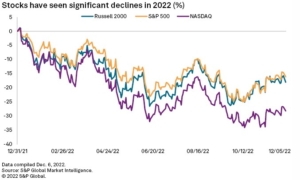What’s in Today’s Report:
- Economic Breaker Panel – November Update
Stock futures are little changed in quiet holiday trading this morning as traders look ahead to the slew of economic data due out in the U.S. today as well as the release of the November Fed meeting minutes.
Economically, the Eurozone Composite PMI Flash came in at 47.8 vs. (E) 47.0 signaling economic contraction in the EU but the better-than-feared headline is helping European shares edge higher today.
This morning is lining up to be a busy one for economic data with Durable Goods Orders (E: 0.3%), Jobless Claims (E: 225K), PMI Composite Flash (E: 48.7), New Home Sales (E: 574K), and Consumer Sentiment (E: 55.0) all due to be released between 8:30 a.m. and 10:00 a.m. ET.
Additionally, the November Fed Meeting Minutes will be released at 2:00 p.m. ET.
Bottom line, with all the recent Fed speak, the Minutes are unlikely to offer any surprises today however data can move markets despite thinning attendance and light volumes. The market wants to see slowing but not collapsing growth measures and a downward acceleration in inflation (today’s inflation expectations within the Consumer Sentiment release will be the key figure to watch). If that materializes, the S&P might be able to break through key near-term technical resistance at 4,007 however high inflation and weaker-than-anticipated growth could send stocks tumbling back toward the lows of the week at 3,900.
All of us at Sevens Report Research are very thankful for your support! Everyone please travel safely, and have a Happy Thanksgiving. We will speak to you again Friday morning.


